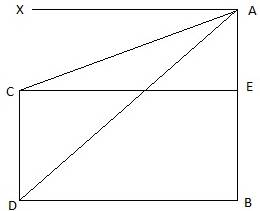From the top of a building AB, 60 m high, the angles of depression of the top and bottom of a vertical lamp post CD are observed to be 30° and 60° respectively. Find
(i) the horizontal distance between AB and CD,
(ii) the height of the lamp post,
(iii) the difference between the heights of the building and the lamp post.

In the above figure, let AB be the building such that AB = 60 m. Join A and X. The angles of depression are ∠CAX = 30° and ∠DAX = 60°. Let CD be the lamp post. Join C,D and B,D and C,E. Since AX is parallel to DB, we must have ∠XAC = ∠ACE = 30° and ∠XAD = ∠ADB = 60°. We get two right-angled triangles ∆ABD and ∆CAE. We use trigonometric angle tan in both the triangles with AB as height and DB as base (for ∆ABD) and AE as height and CE as base(for ∆CAE).
We have to find, (i)BD, (ii)CD, and (iii) AB-CD.
From ∆ABD,
![]()
or,

DB = CE.
From ∆ACE,
![]()
or,
![]()
or,

Hence,
![]()
And, the difference between the heights of the building and the lamp post is,
![]()
Thus our solutions are,
(i) The horizontal distance between AB and CD = 34.64 m.
(ii) The height of the lamp post = 40 m.
(iii) Difference between the heights of the building and the lamp post = 20 m.